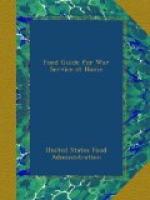The bakers have co-operated loyally. Probably no other food industry has been more vitally affected by the war. ALL BAKERS USING THREE OR MORE BARRELS OF FLOUR A MONTH HAVE BEEN LICENSED AND SO ARE UNDER THE CONTROL OF THE FOOD ADMINISTRATION. This means practically all the commercial bakers of the country, and many hotels, clubs, and institutions. About two-fifths of the bread in the United States is made in bakeries and three-fifths in the home. The bakeries have used 35,000,000 barrels of flour each year, so the importance of this field for conservation is plain.
The amount of wheat flour they are now permitted to have has been reduced: at present 80 per cent of their last year’s quantity, or, if they are pastry and cracker bakers, 70 per cent. They must make no bread wholly of wheat flour. Some substitute must be mixed with the wheat. When the regulation went into effect in February, 1918, 20 per cent was required and later, 25 per cent. In pies and cakes there must be at least one-third substitute. The amounts of sugar and fat used are limited. Even the sizes of the loaves are fixed, so that the extravagance of making and handling all sorts of fancy shapes and sizes may be avoided. Bread must not be sold to the retailer at unreasonable prices.
Victory bread is bread made in accordance with these regulations. The name “Victory” was chosen as representing the idea underlying the conservation of wheat. The name is really a present to the Food Administration, having been used by two large firms who gave up all rights to their trade-mark.
Hotels and restaurants are required to make or serve bread containing at least as much of the wheat substitutes as Victory bread. They may not serve more than two ounces of bread and other wheat products to a guest at a meal. Many of them have recently promised to use no wheat at all till the next harvest. That means, of course, that only through intelligent effort can they serve yeast bread.
THE INDIVIDUAL’S ANSWER TO THE BREAD CRY
UNTIL THE WHEAT-SUPPLY INCREASES AND THE FOOD ADMINISTRATION LESSENS RESTRICTIONS, USE NO WHEAT AT ALL IF YOU CAN POSSIBLY DO WITHOUT. Remember that you can make delicious muffins and other quick breads from the substitute flours. And you need no bread at all at some meals. An extra potato or a serving of rice can be eaten instead of the usual two slices of bread and the body will be supplied with the same amount of energy. Do not be the slave of old food habits. WHEN ALL EUROPE IS EATING TO KEEP ALIVE, FASTIDIOUSNESS AND FOOD “NOTIONS” MUST PLAY NO PART IN THE DIETARY.
Some people find it is almost impossible to do without the baker’s loaf. Hundreds in crowded city quarters have no facilities of their own for baking. Women doing their share in factories and workshops cannot get up earlier to make corn bread for breakfast. Victory bread must be saved for them. For households which must use wheat, the Food Administration has fixed a voluntary ration of 11/2 pounds of wheat per week for each person. This includes wheat in the form of bread, pastry, macaroni, crackers, noodles, and breakfast foods.




